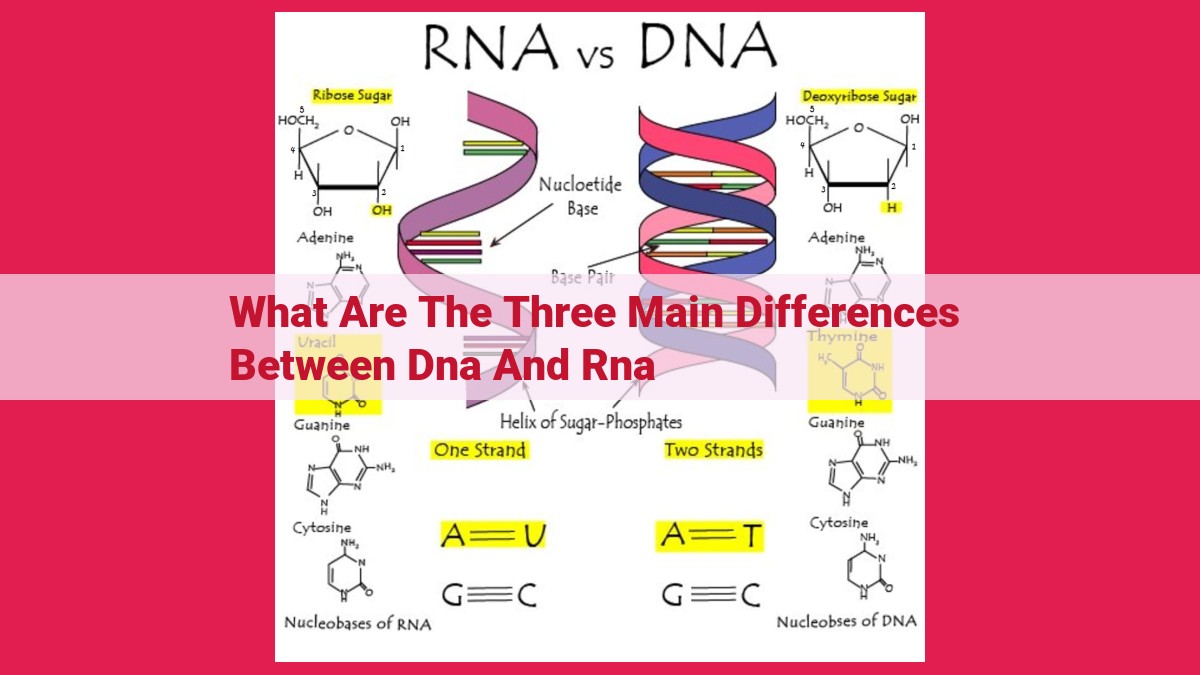Understanding The Differences Between Dna And Rna: Nucleic Acids With Key Biological Functions

DNA and RNA are similar nucleic acids but differ significantly. DNA, a double helix, stores genetic information in its two nucleotide strands. RNA exists as a single strand, capable of intricate folding. Additionally, DNA contains thymine while RNA possesses uracil, a structural difference. Functionally, DNA preserves genetic information, while RNA transmits it for protein synthesis.
Structure: Double Helix vs. Single Strand
- Describe the double helix structure of DNA and its two strands of nucleotides.
- Explain the single-stranded nature of RNA and its ability to fold into complex structures.
Structure: Double Helix vs. Single Strand
In the realm of genetics, two crucial molecules, DNA and RNA, play pivotal roles in storing and transmitting genetic information. While they share a shared mission, their structural designs are distinctly different.
DNA’s Double Helix
Imagine a twisted ladder, with two parallel nucleotide strands forming the sides and nitrogenous bases forming the rungs. This is the double helix structure of DNA, renowned for its stability and capacity to store immense genetic data. The two strands are held together by strong bonds between complementary nitrogenous bases: adenine (A) with thymine (T), and guanine (G) with cytosine (C).
RNA’s Single Strand
In contrast to DNA’s double helix, RNA exists as a single nucleotide chain. While it lacks the stability of a double helix, this structural freedom allows it to fold into complex structures essential for its messenger role in protein synthesis. RNA’s unique ability to fold into three-dimensional shapes provides versatility and facilitates its interaction with proteins, enzymes, and other molecules.
The Composition of DNA and RNA: Nitrogenous Bases
The blueprint of life, DNA, and its RNA counterpart share a remarkable yet distinct composition of nitrogenous bases. These bases are the building blocks of the genetic code, encoding the instructions for every aspect of life.
DNA consists of four nitrogenous bases: adenine (A), cytosine (C), guanine (G), and thymine (T). These bases pair precisely with each other, forming the famous double helix structure. The specific pairing of A with T and C with G ensures the faithful transmission of genetic information from generation to generation.
In contrast, RNA contains a slightly different set of nitrogenous bases: A, C, G, and uracil (U). The absence of thymine and the presence of uracil are key distinctions between DNA and RNA. While uracil plays a pivotal role in RNA by maintaining its structural integrity, thymine remains exclusive to DNA’s double-stranded configuration.
This subtle difference in base composition underscores the functional diversity of DNA and RNA. DNA, with its double-stranded structure and thymine-based pairing, serves as a stable repository for genetic information. RNA, on the other hand, is a dynamic molecule that unfolds into complex structures, facilitating the transfer of genetic information for protein synthesis.
Understanding the nitrogenous bases that make up DNA and RNA is crucial for unraveling the secrets of life. It provides a foundation for comprehending gene expression, genetic inheritance, and the fundamental processes that govern the living world.
DNA vs. RNA: The Dance of Information
In the world of biology, DNA and RNA stand as the two prominent players in the storage, transmission, and expression of genetic information. Each molecule, while sharing fundamental similarities, carries a unique set of characteristics and responsibilities.
DNA: The Library of Life
DNA (deoxyribonucleic acid) is the genetic blueprint of all living organisms. It’s a double helix, a spiral staircase-like structure composed of two strands that twist around each other. Each strand is a sequence of nucleotides, the building blocks of genetic code. There are four nucleotides: adenine (A), cytosine (C), guanine (G), and thymine (T). The nucleotides pair up in a complementary fashion: A with T, and C with G. This pairing creates the rungs of the double helix ladder.
DNA’s primary role is to store genetic information. It holds the instructions for building and maintaining an organism’s cells, tissues, and organs. The information is encoded in the sequence of nucleotides, and when a cell needs to use this information, it makes a copy of the relevant DNA segment.
RNA: The Messenger of the Code
RNA (ribonucleic acid) is a single-stranded cousin of DNA. Its nucleotides are similar to those of DNA, except for one crucial difference: thymine is replaced by uracil (U). RNA also has a more flexible structure, allowing it to fold into complex three-dimensional shapes.
RNA’s primary function is to act as a messenger molecule. It carries genetic information from DNA to the ribosomes, the protein-making machinery of the cell. There are several types of RNA, each with a specific role:
- Messenger RNA (mRNA) carries the coding sequence of genes from DNA to the ribosomes.
- Transfer RNA (tRNA) brings amino acids, the building blocks of proteins, to the ribosomes.
- Ribosomal RNA (rRNA) forms the core of the ribosomes, where protein synthesis takes place.
DNA and RNA, though structurally different, are partners in the essential dance of life. DNA holds the genetic blueprint, while RNA transmits and interprets that code to build and maintain the machinery of living organisms. Their intricate cooperation ensures the proper functioning and inheritance of genetic information across generations.